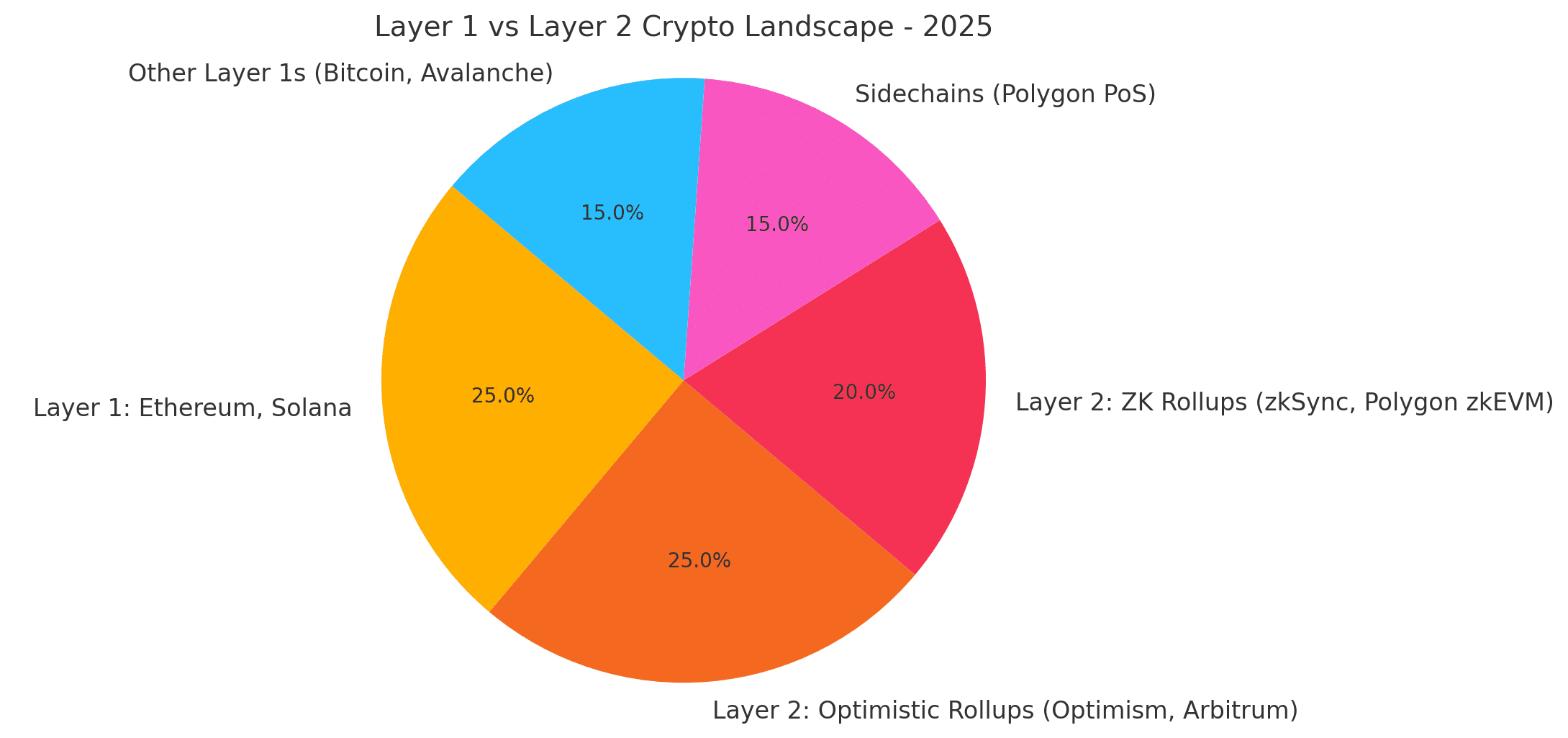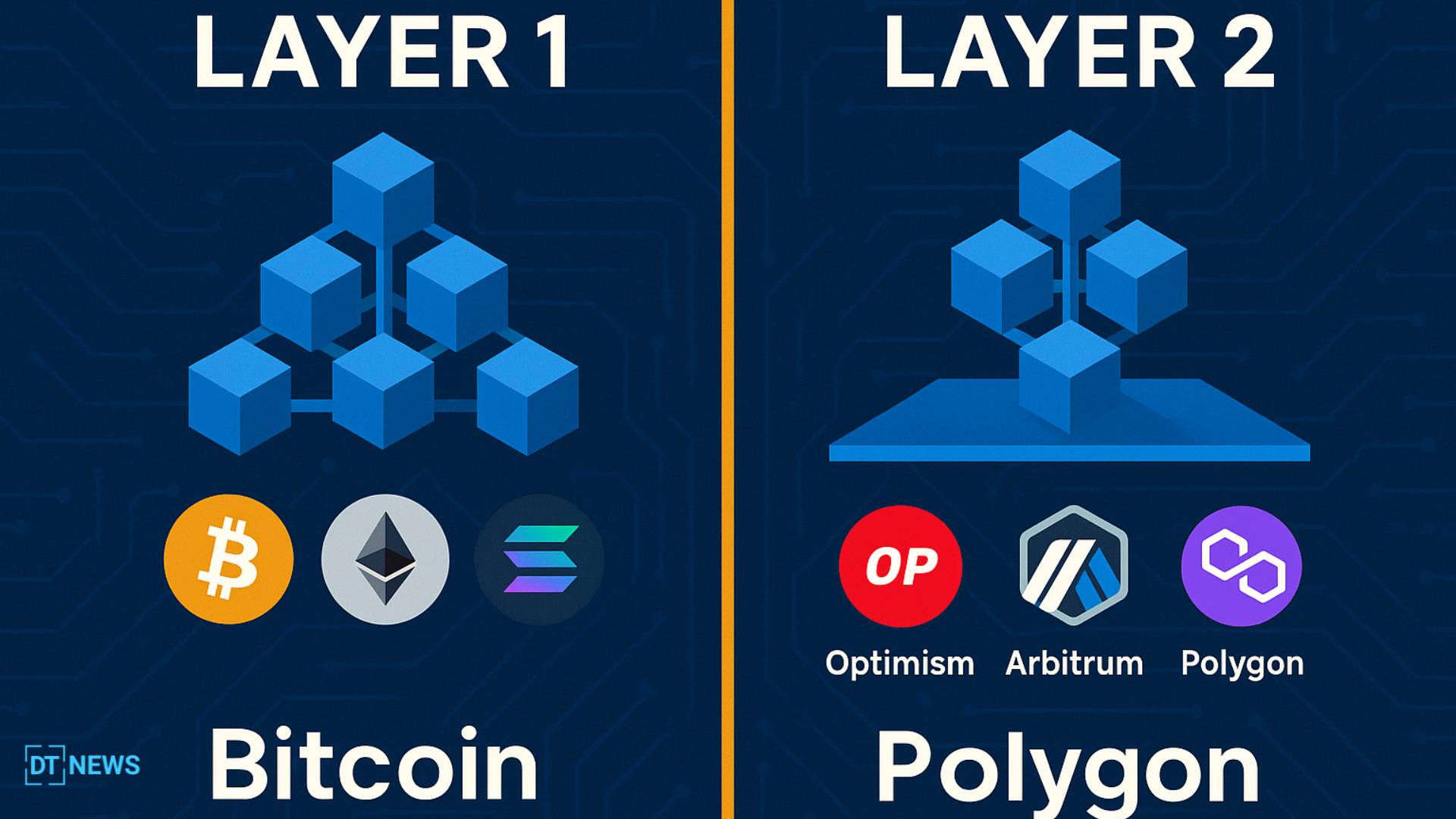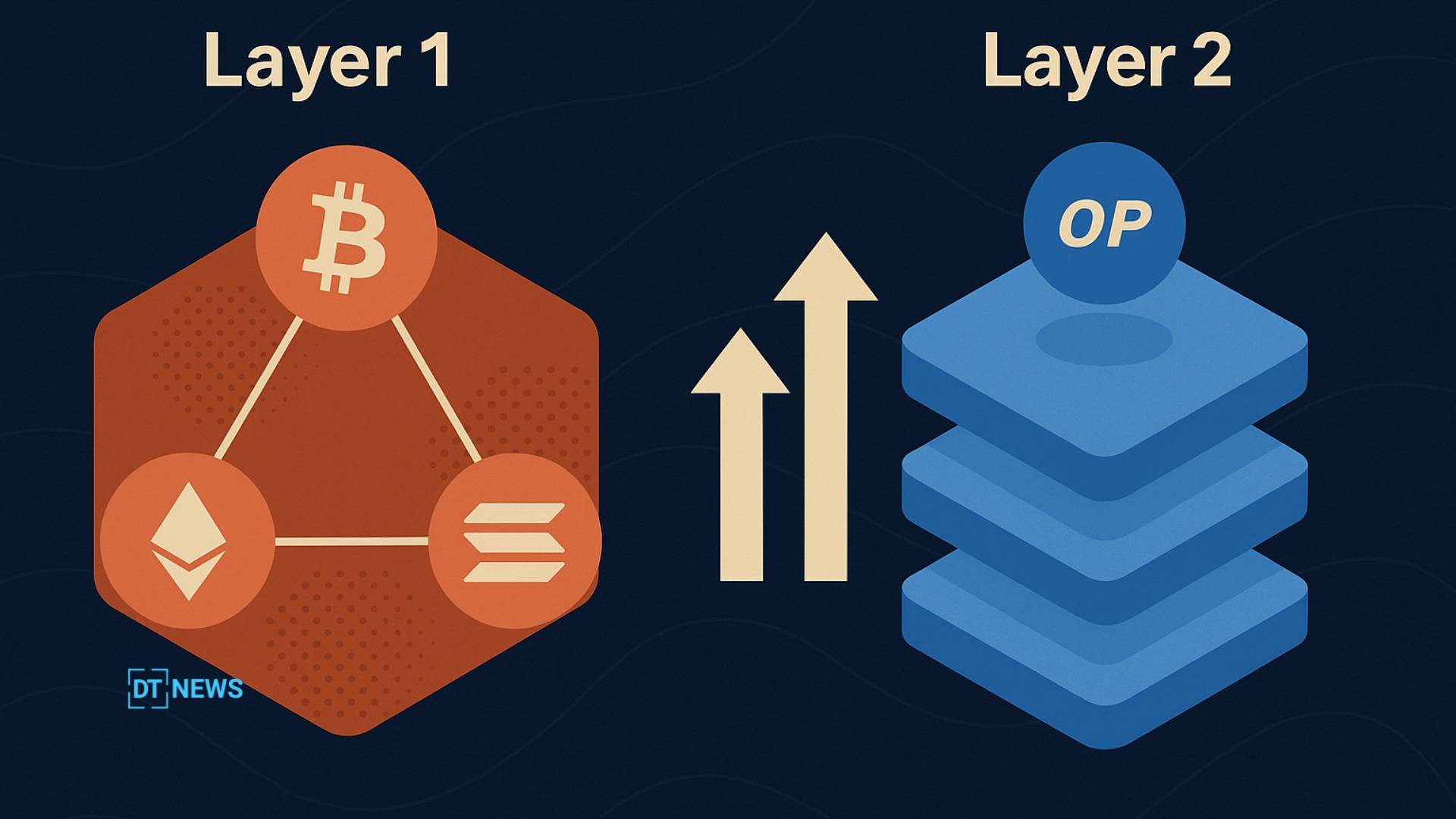As blockchain technology gains traction, there is an increasing demand for quicker, more efficient transaction processing. This has resulted in the development of a layered architecture, which divides blockchain infrastructure into Layer 1 and Layer 2 networks.
- Layer 1 vs Layer 2 Crypto: The Difference
- Layer 1: The Base of Blockchain Infrastructure
- Layer 2: Speed and Efficiency on Top of Layer 1
- Rollups: Optimism, Arbitrum, and ZK Tech
- Layer 1 Examples: Ethereum, Solana, Bitcoin
- Why the Debate: Tradeoffs and the Blockchain Trilemma
- What It Means for Users and Developers
- The Future: Toward Layered Interoperability
- Conclusion: Layered Scaling for the Digital Future
- Glossary of Key Terms
Layer 1 vs Layer 2 Crypto: The Difference
The distinction between layer 1 and layer 2 crypto is crucial to the scaling, user experience, and evolution of blockchains. Layer 1 blockchains, such as Bitcoin, Ethereum, and Solana, ensure transaction security and unanimity.
Layer 2 solutions enhance efficiency, reduce costs, increase speed, and enable decentralized applications by building on the basic layers. Layer 2 solutions, such as Optimism, Arbitrum, and Polygon, work on top to improve scalability, save costs, and optimize performance.
Layer 1: The Base of Blockchain Infrastructure
Layer 1 refers to the core blockchain protocol. Think Bitcoin or Ethereum: they confirm transactions, maintain consensus, and host smart contracts. Their native tokens, BTC, ETH, and SOL, pay for transaction fees and help secure the network.
These networks face a critical challenge: scaling. Bitcoin handles about 7 transactions per second (TPS), and Ethereum previously around 30 TPS before transitioning to Ethereum 2.0 and proof-of-stake. Solutions on this layer include consensus upgrades like Ethereum’s shift to PoS, block-size increases, and sharding. But on-chain improvements alone struggle to handle global demand.

Layer 2: Speed and Efficiency on Top of Layer 1
Layer 2 solutions are precisely what the name suggests—they operate atop layer 1 to take on transaction load. This layer 1 vs layer 2 crypto dynamic offloads computation off-chain, batching activity before settling on the mainnet.
Techniques include:
Optimistic rollups (e.g., Optimism, Arbitrum) assume transactions are valid but allow a challenge window for fraud proof. They’re secure, effective, and currently popular.
Zero-knowledge (zk) rollups use cryptographic proofs for instant finality (e.g., zkSync, Polygon zkEVM).
Sidechains like Polygon operate parallel to Ethereum, with their own consensus but anchor assets back on L1.
State channels and nested chains (e.g., Lightning Network, Plasma) allow repeated off-chain transactions with periodic settlement on L1.
Each of these makes the layer 1 vs layer 2 crypto conversation richer by offering tradeoffs in speed, cost, and security.
Rollups: Optimism, Arbitrum, and ZK Tech
Rollups have emerged as the frontrunners for scaling Ethereum. TastyCrypto and CoreDAO report that optimism and arbitrage account for over 60% of Layer 2 use. Both rely on optimistic rollups, which bundle transactions off-chain before submitting to Ethereum. Optimism’s “Bedrock” update reduced gas prices and accelerated confirmations, while Arbitrum’s several implementations (One, Nova) provide low-cost choices with minor decentralization trade-offs.
Meanwhile, Polygon pioneered Ethereum sidechain use. Its Polygon PoS chain supports thousands of TPS for NFTs, DeFi, and gaming, and it has also launched zkEVM for ZK-rollups. Reddit users typically stress that Polygon is a sidechain (not a genuine Layer 2) and utilizes its own MATIC gas costs, whereas rollups rely on Ethereum gas.
Layer 1 Examples: Ethereum, Solana, Bitcoin
When comparing layer 1 vs layer 2 crypto, remember foundational chains like:
Bitcoin is PoW-based, highly secure, but limited to basic payments (~7 TPS).
Ethereum evolved via The Merge to PoS, enabling future on-chain scale through sharding and upgrades.
Solana is a high-throughput PoS chain built to scale at Layer 1, reaching thousands of TPS directly on the base layer.
These base layers remain the foundation for decentralization and security, while relying on Layer 2s for efficiency.
Why the Debate: Tradeoffs and the Blockchain Trilemma
The layer 1 vs layer 2 crypto tradeoff is based on a fundamental challenge: the blockchain trilemma—balancing scalability, security, and decentralization. Layer 1 improves security and decentralization, but restricts scalability. Layer 2 improves speed and reduces prices, but also introduces complexity and possible trust issues.
Rollups use Layer 1’s security (enforced by fraud or validity proofs) to strike an intelligent equilibrium. Sidechains facilitate application use at a low cost to centralized trust. Direct Layer-1 scaling, like Solana’s concept, provides speed but may undermine decentralization.

What It Means for Users and Developers
Layer 1 vs layer 2 crypto affects daily users’ experiences. Do you want rapid, low-cost transactions? Use Optimism, Arbitrum, or Polygon. Need absolute security and decentralization? Stick with Ethereum or Bitcoin.
Developers make their choices based on the requirements of their dApp. Games and micro-transactions flourish on fast Layer 2 networks. Layer 1 guarantees immutability, which may be necessary for high-value transactions or smart contracts.
Hybrid solutions that combine Layers 1, 2, and 3 (app layer) technology will provide safe, scalable, and user-friendly experiences.
The Future: Toward Layered Interoperability
The struggle between layer 1 vs layer 2 crypto is not binary; rather, it is synergistic. Developers and protocols provide smooth layer bridging, highlighting MEV research across rollups. Danksharding is on Ethereum’s roadmap, and it will increase throughput on both L1 and L2.
New base-layer chains, such as Mitosis, promise to combine Layer 1 security with Layer 2 speed. Coinbase’s Base rollup launches demonstrate how ecosystem stakeholders anticipate Layer 2 to drive widespread adoption.
Conclusion: Layered Scaling for the Digital Future
Layer 1 vs layer 2 crypto is a collaborative effort, not a rivalry. Layer 1 base chains serve as the cornerstone of decentralization and security. Layer 2 rollups and sidechains enable rapid scalability, propelling DeFi, NFTs, and gaming onward. Understanding this layered design is critical for managing the shifting crypto world of 2025.
FAQs
Q1. What is the difference between Layer 1 and Layer 2 crypto?
Layer 1 is the main blockchain; Layer 2 is built on top to improve speed and reduce fees.
Q2. Why are Layer 2 solutions important?
They make blockchains faster and cheaper without sacrificing security.
Q3. Are sidechains like Polygon considered Layer 2?
Not exactly. Sidechains run separately but connect to Layer 1 chains.
Q4. What are rollups in blockchain?
They batch transactions off-chain and settle them on Layer 1.
Glossary of Key Terms
Layer 1
The base blockchain protocol where transactions are executed and finalized. Examples include Ethereum, Solana, and Bitcoin.
Layer 2
A secondary framework or protocol built on top of a Layer 1 blockchain to improve scalability and efficiency. Examples include Optimism, Arbitrum, and zkSync.
Rollups
A Layer 2 solution that processes transactions off-chain and posts compressed data to Layer 1. Includes optimistic and zero-knowledge (ZK) rollups.
Optimistic Rollups
Layer 2 rollups that assume transactions are valid and only run computation in the event of a challenge. Optimism and Arbitrum use this model.
ZK Rollups
Zero-knowledge rollups that use cryptographic proofs to validate transactions instantly before settling them on Layer 1.
Sidechains
Independent blockchains that run parallel to Layer 1 chains but can interact with them through bridges. Polygon PoS is a common example.



















































































































